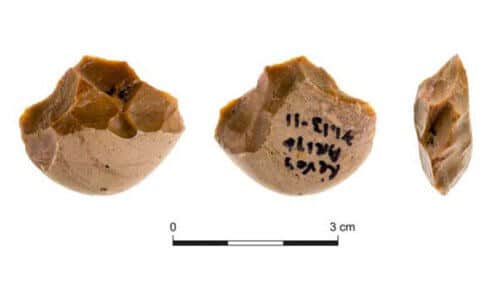The layered site, which was apparently used by humans of the late Homo erectus type, was a favorite site, to which the humans returned again and again. Bone remains of a wide variety of animals were found on the site - elephants, cattle, elk, donkeys and more, which were used as food for the residents

"For many years we have been studying stone tools from prehistoric sites in Israel, in order to find out what they were used for by ancient humans." Prof. Ran Barkai says From the Sonia and Marco Nadler Institute of Archaeology at Tel Aviv University. "One of our most important sources is the Ravadi site, southeast of Gedera - a site under the dome of heaven (as opposed to a cave) from the period between half a million and 300,000 years before our time, rich in finds that have been exceptionally preserved."
"Over time, we discovered that the layered site, which was apparently used by humans of the late Homo erectus type, was a favorite site, to which the humans returned again and again. Bone remains of a wide variety of animals were found at the site - elephants, cattle, elk, donkeys and more, which were used as food for the residents."
Donor of the trimming tool
Now researchers from the Institute of Archeology have deciphered the purpose of flint tools of the 'chopping tools' type found at the prehistoric site in Barbadi. According to the researchers, the people who worked at the Ravadi site developed a diverse and effective stone tool box, which contained a selection of tools for different uses - just like the one used by professionals today. Over time, the researchers were able to decipher the purpose of some of the stone tools found at the site, and now it is the turn of the 'cutting tools' - massive flint pebbles, with one worked edge, very sharp and massive. "Cutting tools were invented in Africa about 2.6 million years ago, and migrated with man wherever he went for the next two million years. They were found in large quantities in almost all prehistoric sites in the old world - in Africa, Europe, the Middle East and even in China - evidence of their great importance. But until now no organized laboratory tests have been carried out to find out what they were used for," explains Prof. Barkai.
With the help of advanced research technologies, the researchers analyzed a sample of 53 cutting tools from the layers site through tests of signs of use and organic remains. For this purpose, they worked in collaboration with researchers from the University of Rome who specialize in these tests. Many scratches and signs of use were discovered on the cutting tools, and on some of them were also found remains of animal bones, which were preserved for almost half a million years. Following the findings, an examination of experimental archeology was also carried out: the researchers collected flint pebbles from the Ravadi area, made replicas of cutting tools themselves, and used them to split the bones of medium-sized dead animals.
Comparing the signs of use and the organic remains on the tools produced in the experiment, with those on the prehistoric chopping tools, greatly strengthened the research conclusions, which hold that tools of this type, which were found at many sites in Africa, Europe and Asia, were used by prehistoric man at the Rabid site for precise crushing of animal bones, Like donkeys, deer and possibly also medium-sized cows and cattle, with the aim of extracting bone marrow from them - a substance with a high caloric value, one of the most nutritious in the animal's body.
"Ancient humans split animal bones mainly to extract the bone marrow from them. This is an operation that requires high skill and great precision, since only a precise splitting of the bone in two prevents crushing and damage to the bone marrow. The type of tool we tested in this study, the cutting tool, was apparently particularly successful, easy to manufacture and effective, and was mainly used for this essential purpose. This is the reason for its widespread distribution, and the fact that it was used for such a long time. The current research has expanded our understanding of the toolbox of ancient humans, and is another landmark in deciphering their lifestyles and tracing the spread of man and human evolution," concludes Prof. Barkai.
More on the subject on the science website:
